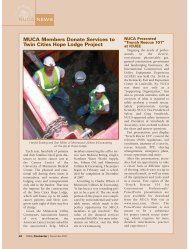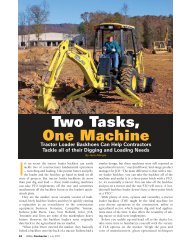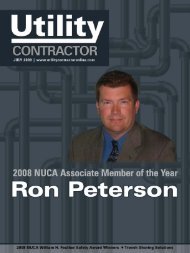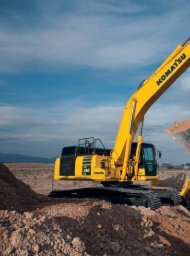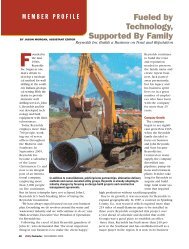View Full December PDF Issue - Utility Contractor Online
View Full December PDF Issue - Utility Contractor Online
View Full December PDF Issue - Utility Contractor Online
You also want an ePaper? Increase the reach of your titles
YUMPU automatically turns print PDFs into web optimized ePapers that Google loves.
Then There<br />
Was Light<br />
<strong>Utility</strong> <strong>Contractor</strong>s Need Not<br />
Fear the Dim Prospect of Being<br />
Left in the Dark<br />
By Todd Razor<br />
Securing reliable light sources to illuminate nighttime construction<br />
projects is imperative for utility contractors whose work requires<br />
them to see in the dark. Light towers allow contractors to continue<br />
working around the clock, and potentially cut in half the number<br />
of days or weeks it would typically take to successfully complete any given<br />
project, while providing well-lit areas that promote safe and productive work<br />
environments. The proper deployment of light towers in the field, whether it<br />
consists of a bridge, a trench, a sidewalk or a street, can also help contractors<br />
meet strict deadlines set by those who employ them.<br />
Going Up?<br />
Though light towers are designed to illuminate large areas,<br />
says Robert Walsh, Product Manager of Portable Energy at<br />
Chicago Pneumatic Construction Equipment, many contractors<br />
don’t take full advantage of those capabilities. Instead, they<br />
place work crews in an atmosphere that resembles a poorly lit<br />
living room rather than an overcast day.<br />
“Many times you will find that operators don’t fully extend<br />
the light tower mast,” Walsh says. “It is a level of comfort<br />
issue. They put the light tower close to what they are working<br />
on, because they think that may be better for them. But you<br />
get more coverage the higher up it goes.”<br />
Ideally, contractors should space out light towers about<br />
every 100 ft on a jobsite, which helps to increase safety and<br />
boost productivity by minimizing blind spots. Having the<br />
correct number of fully extended and appropriately spaced<br />
light towers on jobsites also leads to greater efficiency as<br />
workers don’t have to pause and reposition the machines.<br />
“With a light tower, you are still going to have some pretty<br />
good shadows on a jobsite,” Walsh says. “From a safety<br />
standpoint, you will want to make sure you have not just<br />
one tower, but a series of light towers around workers in<br />
order to minimize those shadows and provide 360 degrees of<br />
illumination on whatever application they are working on.”<br />
26 <strong>Utility</strong> <strong>Contractor</strong> | <strong>December</strong> 2011




